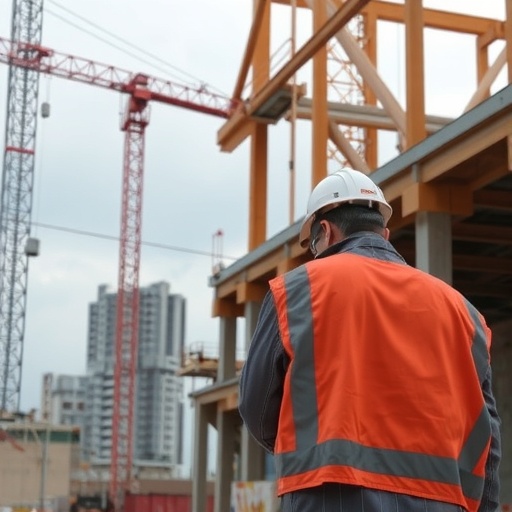The construction industry, long recognized as a cornerstone of modern development and economic growth, is now drawing urgent attention due to a deeply troubling and often overlooked public health issue: a disproportionately high rate of suicide among its workforce. The phenomenon, frequently described as a ‘silent crisis,’ demands comprehensive understanding and immediate action. In a groundbreaking article published in Nature Mental Health, researcher Olli Remes delves into the complex web of factors that contribute to this escalating tragedy and proposes critical pathways toward mitigation and healing. This exploration sheds light not only on the mental health challenges endemic to construction workers but also on the structural and cultural dynamics that have perpetuated their suffering.
At the core of this silent crisis is the alarming observation that workers in the construction industry experience suicide rates significantly above the general population. This discrepancy is not incidental but symptomatic of a combination of unique occupational stresses intertwined with cultural norms that dissuade the acknowledgment or discussion of mental health issues. Long working hours, physically demanding labor, job insecurity, and exposure to hazardous environments compound psychological strain, but it is the pervasive stigma around mental health that often isolates workers, leaving them vulnerable and unsupported.
Remes emphasizes that traditional occupational health frameworks have insufficiently addressed mental health, focusing instead on physical safety protocols. While safety helmets and harnesses have drastically reduced physical injuries, comparable rigor has not been applied toward psychological well-being. The construction industry’s hyper-masculine identity often equates vulnerability with weakness, effectively silencing conversations about mental health. In this environment, workers at risk of suicide may suffer in silence, lacking accessible, unbiased avenues for support.
Detailed epidemiological data confirm that men in manual labor sectors, particularly construction, are at heightened risk of suicide, frequently due to untreated depression, anxiety, and substance misuse. However, the data also reveals a troubling gap in diagnosis and intervention, partly driven by workplace cultures that discourage help-seeking behaviors. Most suicide prevention programs fail to reach construction workers because they are poorly tailored to their specific social realities and occupational structures.
Understanding the intersection of job-related factors and mental health requires an interdisciplinary approach. Psychosocial stressors in construction include precarious employment conditions resembling a gig economy—short contracts, layoffs tied to project cycles, and financial instability. These stressors exacerbate feelings of hopelessness and loss of control, potent triggers for suicidal ideation. Moreover, witnessing accidents and fatalities can lead to trauma and post-traumatic stress disorder, which often go unaddressed.
Technological advances can serve as both a boon and a bane in this context. On one hand, digital mental health interventions leveraging smartphones and AI can provide discreet, immediate support and screening. On the other, the isolating nature of remote or algorithm-driven interactions may fail to substitute for human connection and empathetic alliance. Remes advocates for hybrid models that blend technology with ongoing community engagement and peer support programs.
Importantly, addressing the crisis requires shifting away from fragmented activities toward systemic reforms. Industry stakeholders—including employers, unions, healthcare providers, and policymakers—must collaborate to embed mental health promotion into existing occupational safety frameworks. This means training supervisors to recognize mental health warning signs, creating confidential reporting systems, and establishing robust referral networks for professional care.
Financial incentives and regulatory mandates could further drive change by holding companies accountable for mental health outcomes, much as they do for physical injury prevention. Deploying rigorous data collection and surveillance systems tailored to measure psychological injury will be crucial for tracking progress and identifying at-risk populations. Data transparency can catalyze innovation and accountability.
The article also highlights the importance of cultural transformation within the construction sector. Changing entrenched masculine norms requires meaningful dialogue and visible leadership commitment from senior figures who champion mental health openly. Peer-support initiatives and storytelling that humanize the struggles of workers can erode stigma and foster resilience.
Furthermore, community-wide strategies that extend beyond the construction site may improve outcomes by addressing social determinants of mental health. Access to affordable housing, stable income support, and family services mitigate external pressures that compound workplace stress. Such holistic approaches align with growing evidence that mental health is inseparable from broader social and economic conditions.
Remes’ analysis warns against “one-size-fits-all” approaches, urging tailored interventions that reflect diversity within the construction workforce, including differences in age, ethnicity, and job role. Younger workers may face distinct risk factors related to career instability and lack of experience, while older workers contend with physical decline and job displacement fears. Intersectional strategies allow for more precise prevention efforts.
Beyond prevention, there is a call to enhance postvention supports—services provided after a suicide to aid colleagues, families, and communities in recovery and to prevent contagion effects. Remes underscores that these programs are often under-resourced in high-risk industries, representing a missed opportunity to build long-term resilience.
Internationally, comparisons reveal that countries with integrated occupational health policies and inclusive labor protections demonstrate lower suicide rates in construction. Cross-border knowledge exchange and adoption of best practices can accelerate improvements worldwide. Building a global coalition dedicated to mental health in construction is both possible and necessary.
In conclusion, the ‘silent crisis’ of suicide in the construction industry constitutes a profound occupational and societal challenge that demands urgent, multifaceted intervention. Olli Remes’ study provides an essential foundation for understanding this complex issue, but it is now incumbent upon all stakeholders to transform insight into action. A future in which construction workers enjoy not only physical safety but also mental well-being is achievable—but only if the silence is broken and the crisis confronted with determination and compassion.
Subject of Research: Understanding suicide risk and mental health challenges in the construction industry
Article Title: Understanding the ‘silent crisis’ of suicide in the construction industry and the way forward
Article References:
Remes, O. Understanding the ‘silent crisis’ of suicide in the construction industry and the way forward. Nat. Mental Health (2025). https://doi.org/10.1038/s44220-025-00487-3
Image Credits: AI Generated




